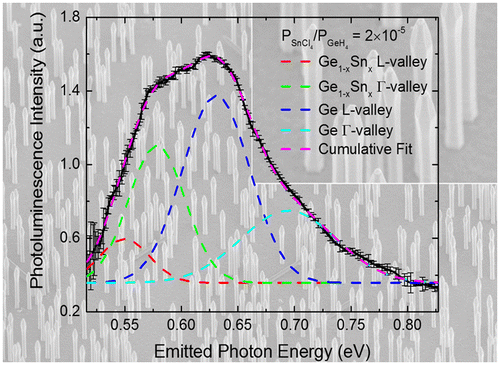当前位置:
X-MOL 学术
›
Nano Lett.
›
论文详情
Our official English website, www.x-mol.net, welcomes your
feedback! (Note: you will need to create a separate account there.)
Core-Shell Germanium/Germanium–Tin Nanowires Exhibiting Room-Temperature Direct- and Indirect-Gap Photoluminescence
Nano Letters ( IF 9.6 ) Pub Date : 2016-11-10 00:00:00 , DOI: 10.1021/acs.nanolett.6b03316 Andrew C. Meng 1 , Colleen S. Fenrich 1 , Michael R. Braun 1 , James P. McVittie 1 , Ann F. Marshall 1 , James S. Harris 1 , Paul C. McIntyre 1
Nano Letters ( IF 9.6 ) Pub Date : 2016-11-10 00:00:00 , DOI: 10.1021/acs.nanolett.6b03316 Andrew C. Meng 1 , Colleen S. Fenrich 1 , Michael R. Braun 1 , James P. McVittie 1 , Ann F. Marshall 1 , James S. Harris 1 , Paul C. McIntyre 1
Affiliation

|
Germanium–tin alloy nanowires hold promise as silicon-compatible optoelectronic elements with the potential to achieve a direct band gap transition required for efficient light emission. In contrast to Ge1–xSnx epitaxial thin films, free-standing nanowires deposited on misfitting germanium or silicon substrates can avoid compressive, elastic strains that inhibit formation of a direct gap. We demonstrate strong room temperature photoluminescence, consistent with band edge emission from both Ge core nanowires, elastically strained in tension, and the almost unstrained Ge1–xSnx shells grown around them. Low-temperature chemical vapor deposition of these core-shell structures was achieved using standard precursors, resulting in Sn incorporation that significantly exceeds the bulk solubility limit in germanium.
中文翻译:

核-壳锗/锗-锡纳米线展现室温下的直接和间接间隙光致发光
锗锡合金纳米线有望成为与硅兼容的光电元件,有望实现有效发光所需的直接带隙跃迁。与Ge 1- x Sn x外延薄膜相反,沉积在不匹配的锗或硅衬底上的自立式纳米线可以避免抑制直接间隙形成的压缩弹性应变。我们展示了强大的室温光致发光,与两条Ge核纳米线的带边发射,在张力上弹性应变的Ge以及几乎未应变的Ge 1– x Sn x一致周围长有贝壳。使用标准前体可实现这些核-壳结构的低温化学气相沉积,从而导致掺入的Sn大大超过了锗的整体溶解度极限。
更新日期:2016-11-10
中文翻译:

核-壳锗/锗-锡纳米线展现室温下的直接和间接间隙光致发光
锗锡合金纳米线有望成为与硅兼容的光电元件,有望实现有效发光所需的直接带隙跃迁。与Ge 1- x Sn x外延薄膜相反,沉积在不匹配的锗或硅衬底上的自立式纳米线可以避免抑制直接间隙形成的压缩弹性应变。我们展示了强大的室温光致发光,与两条Ge核纳米线的带边发射,在张力上弹性应变的Ge以及几乎未应变的Ge 1– x Sn x一致周围长有贝壳。使用标准前体可实现这些核-壳结构的低温化学气相沉积,从而导致掺入的Sn大大超过了锗的整体溶解度极限。

































 京公网安备 11010802027423号
京公网安备 11010802027423号